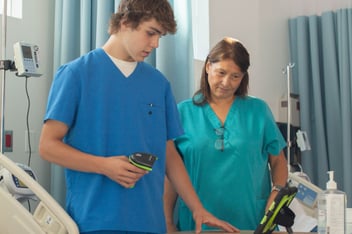How to Harness the Power of Escape Rooms for Simulation-Based Learning
Medical error is the third leading cause of death in America, and many of these deaths are related to breaks in communication and disorganization among the interdisciplinary team. Simulation-based education has a proven track record of addressing these challenges. One newer approach we’ve been implementing is to incorporate escape rooms.
Escape rooms have revolutionized team-building activities across various industries, but their potential extends far beyond corporate settings. In the realm of nursing education, where teamwork and effective communication are paramount, escape rooms offer a dynamic approach to simulation-based learning.
In this two-part series, we’ll delve into the benefits of incorporating escape rooms into nursing simulations and offer a guide for designing your own.
What Is an Escape Room, and How Can They Be Used in Nursing Education?
Escape rooms are collaborative experiences where participants work together to solve puzzles, unravel mysteries, and “escape” the room within a time limit. Traditionally used for team building, these rooms promote critical thinking, communication, and problem-solving skills. In nursing simulations, these same skills are essential for effective patient care, making escape rooms a natural fit for nursing education.
The keys to success in patient care on a busy nursing unit are to have excellent communication and critical thinking skills, to assess patient conditions and match them to your assembled team’s strengths, and to keep the needs of the unit as a whole in mind while adjusting to the everchanging patient care priorities. Nursing teams change day to day, and it is important to have open communication and support for one another. Basically, nurses use skills every day that can be refined and developed in an escape room.
Designing Nursing Escape Rooms
Nursing simulation design can be complex, requiring careful consideration of learning objectives, scenario development, and logistical planning. Escape rooms offer a flexible alternative, allowing educators to tailor simulations to specific content needs and learning outcomes. By incorporating themes relevant to nursing practice, such as disease management or emergency care, escape rooms engage students while reinforcing clinical concepts.
The choice of themes for a nursing escape room is endless. They don’t necessarily need to follow the commercial escape room themes (i.e., being trapped in a bank vault, saving the world from a ticking bomb, or solving a museum heist). Nursing escape rooms can mix fanciful themes with clinical content.
For example, one escape room I co-created was pirate themed, but all the pirates had different chronic diseases and the nursing staff needed to prioritize which pirate needed what type of care in order to find the buried treasure before the tide came in.
Alternatively, you could use a more traditional patient care area as part of the theme. The two escape rooms from the Sim2Grow team, Mock Code Mystery and Med Room Mayhem (both available for download on the resource download page), are clinically focused in the setting of a simulation lab.
Overcoming Nursing Simulation Challenges
Escape room design for nursing education presents several challenges, but with some experience and an open mind, they become easier to implement (and more fun, too).
Designing escape rooms becomes easier with experience and with the use of a template. It also helps to develop escape rooms as a small group with two to four designers, including a subject matter expert for the topic to be covered. This way, you avoid both the pitfall of tunnel vision as well as the “too many cooks in the kitchen” effect.
Give yourself plenty of time to develop and test your escape room. It is critical to conduct dry runs with people similar to the target audience who were not involved in the design of the escape room. It is shocking to see what you initially considered simple and straightforward become a barrier to potential escapees. Remember, you want the participants to stay engaged, not frustrated.
The End Result: Effective Education and Engaged Nursing Students
Feedback from nursing students who have participated in escape room simulations is overwhelmingly positive.
Students find the experience enjoyable, engaging, and effective in improving teamwork and communication skills. By fostering a sense of camaraderie and shared accomplishment, escape rooms create memorable learning experiences that resonate with students long after the simulation ends.
But it’s not just the students who like them. Research findings indicate that escape rooms enhance knowledge retention, motivation to study, and teamwork skills among students. These findings underscore the value of integrating escape rooms into nursing curricula as a complementary approach to traditional simulation-based learning.
Conclusion
Escape rooms offer a creative and engaging method for enhancing nursing education through simulation. By promoting teamwork, critical thinking, and communication, escape rooms empower nursing students to excel in clinical practice. As educators continue to explore innovative teaching strategies, escape rooms stand out as a compelling tool for preparing the next generation of nurses. With proper design and implementation, escape rooms have the potential to transform nursing education and improve patient outcomes.
As educators, let's embrace this immersive learning experience and unlock the full potential of escape rooms in nursing education.



.webp?width=352&name=s%20(4).webp)